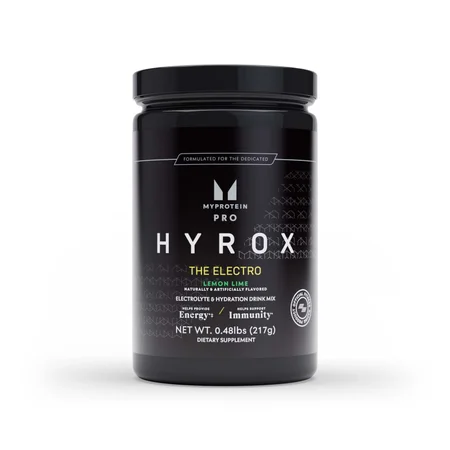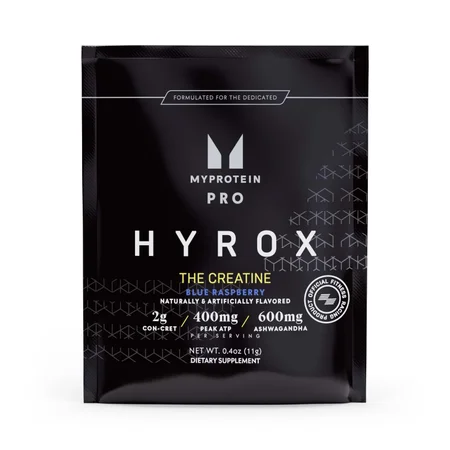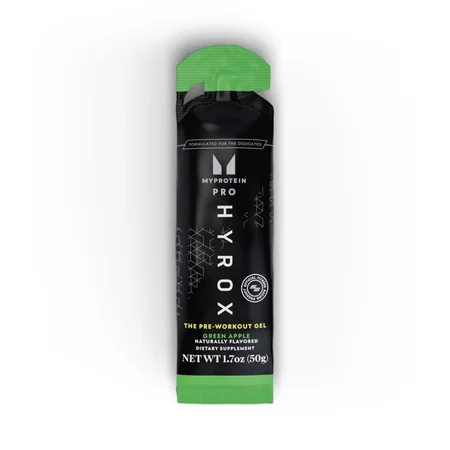
Hybrid training is only getting more popular, just ask that friend who’s always trying to sign you up for a HYROX.
Combining resistance training and cardio, hybrid training incorporates traditional programs that utilize strength and endurance to offer a more dynamic fitness experience.
Whether you’re looking for a more balanced routine or simply wanting to enhance performance – hybrid training could be the way to go.
- Benefits of Hybrid Training Programs
- Who Can Benefit from Hybrid Training?
- Key Principles of Hybrid Training
- Setting Goals for Hybrid Training
- Designing a Balanced Hybrid Training Schedule
- Hybrid Training Workout Splits
- Hybrid Training for Different Fitness Levels
- Equipment Essentials for Hybrid Training
- Hybrid Training for Busy Lifestyles
- Adapting Hybrid Training for Specific Goals
- Hybrid Training and Age
- The Role of Technology in Hybrid Training
Benefits of Hybrid Training Programs
Hybrid training programs combine the best of both worlds—strength and endurance. This combination offers numerous benefits, including:
- Enhanced overall fitness: By training both strength and endurance, hybrid programs help in the improvement of cardiovascular health, strength, and overall physical conditioning, leading to a more well-rounded fitness profile.
- Increased calorie burn: The combination of strength and endurance exercises in a hybrid program maximizes calorie burn during and after workouts, supporting fat loss and muscle definition.
- Improved athletic performance: Athletes can benefit from hybrid training with the chance to improve their ability across multiple factors like speed, power, and stamina. All essential for sports that require physical demands.
- Reduced workout monotony: The variety in hybrid training keeps workouts interesting and engaging, reducing the risk of boredom and workout fatigue.
- Functional fitness: Hybrid training often focuses on compound movements that mimic real-life activities, improving functional fitness and reducing the risk of injury in everyday tasks.
Who Can Benefit from Hybrid Training?
Hybrid training is versatile and adaptable, making it suitable for various individuals:
Athletes: Those looking to improve performance across different aspects of their sport. Fitness enthusiasts: Individuals who enjoy both strength training and cardio and want to combine them in a structured way. Weight loss & aesthetic goals: People who aim to lose weight and tone their bodies can benefit from the high calorie-burning nature of hybrid training. Busy people: Those with limited time can use hybrid training to maximize the efficiency of their workouts.
Key Principles of Hybrid Training
The foundation of a successful hybrid training program lies in several key principles that are similar to other traditional programs:
Balance: Ensure your program balances strength and endurance to avoid overtraining one aspect at the expense of the other. Progressive overload: Increase intensity gradually throughout your workout to continue your progress, whether that be the speed you move or the load you lift. Periodization: Structure your training in cycles to focus on different aspects of fitness, allowing time for recovery and adaptation, which could take the form of deload or recovery weeks. Recovery: Incorporate adequate rest and recovery periods to prevent overtraining and injury either between sessions or muscle groups, as well as within the sessions. Nutrition: Support your training with a balanced diet rich in protein, carbohydrates, and healthy fats, essential for energy, recovery, and muscle growth.

Macro Calculator | How to Calculate Your Macros for Flexible Dieting and IIFYM
Use our calculator to work out your macros....
Setting Goals for Hybrid Training
Setting clear, achievable goals is crucial for the success of any training program. When establishing goals for hybrid training, you should:
Define specific objectives: Determine whether you want to improve endurance, build strength, lose weight, or enhance overall fitness. Set measurable targets: Use measurable benchmarks, such as running a certain distance, or lifting a specific weight, to help track progress. Establish a timeline: Set realistic deadlines for achieving your goals, keeping in mind the importance of gradual progress. Stay flexible: Be prepared to adjust your goals as you progress, especially as your fitness level improves.
If in doubt or if you need some help (especially on the realistic side of goals), contact a trainer or specialized professional to support you.
Designing a Balanced Hybrid Training Schedule
Creating a balanced hybrid training schedule involves integrating various forms of exercise to ensure all fitness components are addressed. A typical weekly schedule might include:
Strength training: 2-3 days focusing on compound movements which work multiple muscle groups like squats, deadlifts, and bench presses. Endurance training: 2-3 days of cardio, such as running, cycling, or swimming. Flexibility and mobility: 1-2 days of yoga, stretching, or mobility exercises. High intensity interval training (HIIT): 1-2 sessions per week to boost cardiovascular fitness while burning calories efficiently.
Adjust the frequency and intensity of each component based on your individual goals and fitness level.
Strength training in a hybrid program
Strength training is a vital component of hybrid training, focusing on building muscle mass, enhancing strength, and improving metabolic rate.
Key elements include:
- Compound movements: Focus on exercises like squats, deadlifts, bench presses, and rows, which work multiple muscle groups simultaneously.
- Accessory exercises: Accessory exercises can be used to target specific muscles which may not have been worked by compound movements. For example, bicep curls to isolate the biceps.
- Proper form: Maintain proper technique to maximize effectiveness and prevent injuries.

Your Mega Guide To Strength Training | PT-Approved
Your in-depth guide to strength training....
Incorporating endurance training into hybrid workouts
Endurance training in hybrid programs improves cardiovascular health, increases stamina, and supports weight management. Consider the following:
Variety of cardio: Include different types of cardio exercises, such as running, cycling, rowing, or swimming, to keep workouts varied and challenging. Steady-state vs. interval training: Alternate between steady-state cardio (e.g., a long, slow run) and interval training (e.g., high intensity or sprints) to develop both aerobic and anaerobic endurance. Consistency: Regular cardio sessions are key to building and maintaining endurance.

What Is Aerobic Endurance? | Definition, Test & Training
Get on the fast track to better endurace with these aerobic training tips....
Flexibility and mobility: essential components
Flexibility and mobility are often overlooked but are essential for a well-rounded hybrid training program. These components improve range of motion, massively reduce injury risk, and enhance overall performance.
Stretching: Incorporating both static and dynamic stretching into your routine can help maintain and improve flexibility. Using dynamic to assist warming up and static to improve joint movement. Mobility drills: Use mobility drills to enhance joint flexibility, particularly in areas prone to stiffness, such as the hips, shoulders, and spine. Yoga and Pilates: These practices not only improve flexibility but also build core strength and stability, which are crucial for both strength and endurance training.

Yoga Vs. Pilates — What's The Difference?
Both are good for you, but which should you try?...
High-intensity interval training (HIIT) in hybrid programs
HIIT is a powerful tool in hybrid training, offering a time-efficient way to improve cardiovascular fitness, burn fat, and build muscle. Incorporate HIIT into your program by:
Short, intense workouts: Perform exercises at high intensity for short periods then resting for intervals (e.g., 30 seconds of exercise then 30 seconds rest). Mixing exercises: Combine strength and cardio movements (e.g., burpees, kettlebell swings) to maximize calorie burn and enhance metabolic conditioning.

10 Best Supplements For HIIT & Running | Adidas Runtastic x Myprotein
Plus a free trial of Adidas Runtastic Premium.......
Hybrid Training Workout Splits
Here are sample hybrid training plans for different goals:
Beginner: 2 days of strength training, 2 days of cardio, and 1 day of flexibility/mobility only work. Intermediate: 3 days of strength training, 3 days of cardio (including 1 HIIT session), and 2 days of flexibility/mobility work or embedded into sessions. Advanced: 4 days of strength training, 3 days of cardio (including 2 HIIT sessions), and 2 days of flexibility/mobility work or embedded into sessions.
Recovery and rest: preventing overtraining
Recovery is just as important as the workouts themselves in a hybrid training program. Overtraining can lead to injury, burnout, and diminished performance.
To prevent overtraining:
Listen to your body: Pay attention to signs of fatigue, soreness, or decreased performance, which may indicate the need for rest. Incorporate rest days: Schedule regular rest days to allow your body to recover. You’re less likely to suffer from ailments like the common cold with 2 days of rest instead of 1. Active recovery: Engage in low-intensity activities, such as walking or gentle yoga, on rest days to promote blood flow and aid recovery. Nutrition and hydration: Support recovery with adequate protein and carbohydrate intake, hydration, and nutrient-dense foods.

The Right Recovery for Your Body
maximize recovery potential to power your progress......
Tracking progress and adjusting your program
Tracking your progress is essential for staying motivated and making necessary adjustments to your hybrid training program. Consider the following methods:
Training logs: Keep a detailed log of your workouts, including exercises, sets, reps, weights, and cardio sessions. Performance metrics: Track specific performance metrics, such as running pace, weight lifted, or heart rate. Regular assessments: Periodically assess your progress towards your goals, and adjust your program as needed to overcome plateaus. Use technology: Fitness apps, wearables, and smartwatches can help you monitor and analyze your training data in real time.
Hybrid Training for Different Fitness Levels
Hybrid training can be tailored to different fitness levels:
Beginners: Start with basic exercises and gradually increase intensity and complexity. Focus on mastering form and building a solid foundation in both strength and endurance. Intermediate: Increase the volume and intensity of workouts, incorporating more advanced techniques like supersets and interval training. Advanced: Challenge yourself with complex movements, heavier weights, and more intense intervals. Consider prioritizing your training for specific events.
Equipment Essentials for Hybrid Training
Training with the right equipment can improve your overall hybrid experience – here are few to look into:
Weights: Dumbbells, barbells, kettlebells, and resistance bands are great for strength training. Cardio equipment: A treadmill, stationary bike, or rowing machine can be useful for indoor cardio sessions. Mobility tools: Foam rollers, yoga mats, and resistance bands can aid in flexibility and mobility work. Wearables: Fitness trackers and smartwatches can help monitor your progress and ensure you're training at the right intensity. However, you can still start if you don’t have any equipment.
Bodyweight vs. weighted exercises in hybrid programs
Both bodyweight and weighted exercises have a place in hybrid training:
Bodyweight exercises: Great for improving functional fitness, core strength, and mobility while being versatile and easy to do anywhere, taking away the need for equipment. Weighted exercises: Effective for building muscle mass, increasing strength, and enhancing metabolic rate. Weighted exercises are particularly beneficial for those looking to achieve specific strength goals.
Improving athletic performance with hybrid training
Athletes can use hybrid training to enhance their performance in specific sports:
Sport-specific drills: Incorporate drills that mimic the movements and energy demands of your sport. Balance training: Focus on improving balance, coordination, and agility, which are crucial for most sports. Conditioning: Use hybrid training to improve both aerobic and anaerobic conditioning, ensuring you’re prepared for the demands of your sport.
Mental resilience and hybrid training
Mental toughness is just as important as physical strength in a hybrid training program. Here are the mental resilience benefits hybrid training can offer:
Challenge and variety: The diverse nature of hybrid training keeps you mentally engaged, constantly challenging your body and mind. Pushing limits: By integrating high-intensity exercises and complex movements, hybrid training pushes you out of your comfort zone, fostering mental grit and helping you push through. Goal setting: Regularly setting and achieving goals in a hybrid program boosts confidence and determination.
Hybrid Training for Busy Lifestyles
Hybrid training is ideal for those with busy schedules. It allows you to achieve a comprehensive workout in less time:
Efficient workouts: Combine strength and cardio in single sessions to maximize your workout time. High intensity interval training (HIIT): Incorporate HIIT sessions for quick, effective workouts that can be done in 20-30 minutes. Home workouts: Use bodyweight exercises and minimal equipment to create an effective hybrid workout at home.
Adapting Hybrid Training for Specific Goals
Hybrid training can be adapted to prepare for specific goals such as:
Marathons: Focus on endurance training with long-distance running, complemented by strength training to enhance muscle endurance and prevent injury. Triathlons: Balance swimming, cycling, and running with strength and flexibility exercises to improve overall performance. HYROX: Incorporate functional strength exercises and high-intensity cardio sessions to prepare for this unique combination of fitness challenges. Team sports: Training different physical capacities is a long-used technique for athletes from invasion and power sports where they need to be strong and powerful as well as be able to cope with a long duration. Strength: Lifting heavy in strength sessions can lead to gains which in turn allow you to increase the weight you use. Keeping up the cardio and implementing sprint intervals can keep the type two fibres working and build on them while increasing health and well-being. Fat loss: Training multiple things and continuously moving are the best things here, so keep alternating and adapting workouts to see the fat reduce, with bigger muscles being worked in strength and then used in the cardio as well to impact metabolism. Hypertrophy: Similar to strength gains, but using a higher volume in resistance training and slightly longer intervals to increase lactate and utilize it for growth benefits.
Hybrid Training and Age: Tailoring Programs for Different Life Stages
Hybrid training can be tailored to different age groups:
Adolescents: Focus on developing balance and coordination while prioritizing broad goals for maximum long-term development. Young Adults: Focus on building strength and cardiovascular fitness, with an emphasis on technique and injury prevention. Middle-Aged Adults: Prioritize maintaining muscle mass and cardiovascular health, with a balanced approach to strength, endurance, and flexibility. Seniors: Adapt exercises to maintain mobility, balance, and functional strength, with a focus on low-impact movements and sufficient recovery.
The Role of Technology in Hybrid Training
Technology plays a crucial role in enhancing hybrid training:
Fitness apps: Track your workouts, set goals, and monitor progress using fitness apps tailored to hybrid training. Wearables: Use smartwatches and fitness trackers to measure heart rate, calories burned, and other key metrics. Online communities: Join online forums and social media groups to share experiences, get advice, and stay motivated.
Take Home Message
Hybrid training is a refreshing approach to fitness – incorporating both strength and endurance, creating a dynamic workout routine that never grows stale.
Whether you’re a seasoned athlete or a complete beginner, hybrid training has something for you.
By setting clear goals and balancing your schedule, you’ll be achieving the goals set while keeping your workout routine interesting and exciting.
All the advice in this article applies generally, but for a specific and tailored program that directly meets your ability and goals, speak to a hybrid trainer.
FIND MORE HERE:

Best & Worst HYROX Stations, Voted By You
It was never gonna end well for burpees....

Everything You Need To Know About HYROX
Your complete guide to HYROX events....

How I'm Preparing For The HYROX World Championships
'It's about aligning your lifestyle with your goals.'...












